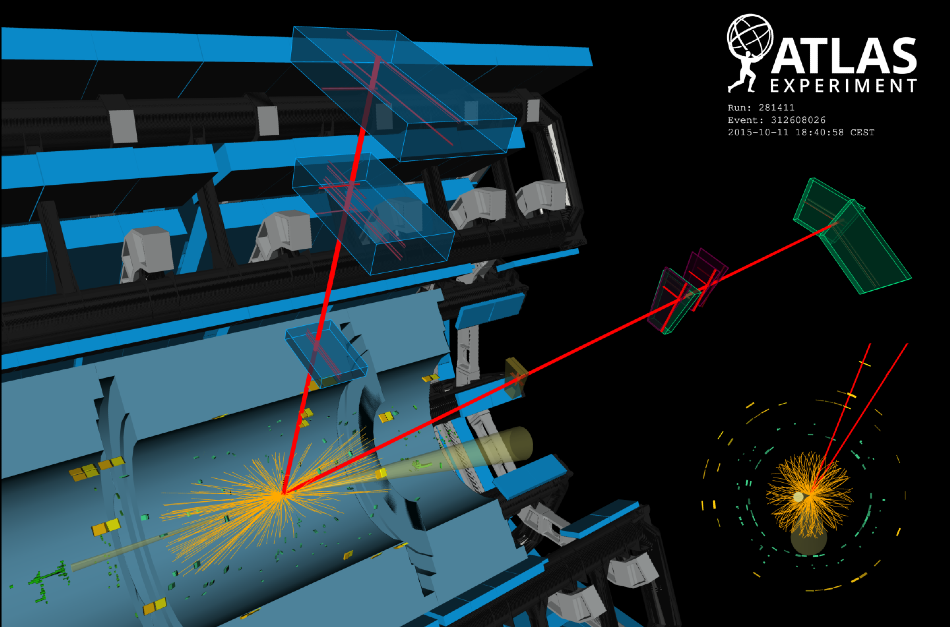Aug 4 2020
The latest results of the CMS and ATLAS experiments were recently announced at the 40th ICHEP conference.
 A Run 2 ATLAS event containing two muons (red) with mass compatible with that of the Higgs boson, and two forward jets (yellow cones). Image Credit: ATLAS Collaboration/CERN.
A Run 2 ATLAS event containing two muons (red) with mass compatible with that of the Higgs boson, and two forward jets (yellow cones). Image Credit: ATLAS Collaboration/CERN.
The results revealed that the Higgs boson disintegrates into a pair of muons, which are heavier versions of electrons—one of the fundamental particles that make up the matter content of the Universe.
Although electrons are categorized as a first-generation particle, muons are classified as a second-generation particle.
The procedure of the Higgs boson disintegrating into muons is a rare physics phenomenon because only around one Higgs boson in 5000 is known to disintegrate into muons.
With regard to fundamental physics, these latest outcomes have crucial significance because they indicate that the Higgs boson communicates with second-generation fundamental particles, for the first time.
CERN physicists have been investigating the Higgs boson ever since it was identified in 2012 to analyze the characteristics of this highly unique particle. Created from proton collisions at the Large Hadron Collider (LHC), the Higgs boson decays or disintegrates almost immediately into other kinds of particles.
One of the major techniques of analyzing the properties of the Higgs boson is the study of the way it disintegrates into the numerous elementary particles and the speed of decay.
CMS acquired proof of this disintegration with 3 sigma, meaning that the possibility of observing the disintegration of the Higgs boson into a pair of muons from a statistical variation is less than 1 in 700.
The two-sigma result of the ATLAS experiment indicates that the odds are 1 in 40. The integration of these results would boost the importance well above 3 sigma and offers robust proof of the disintegration of the Higgs boson into a pair of muons.
CMS is proud to have achieved this sensitivity to the decay of Higgs bosons to muons, and to show the first experimental evidence for this process. The Higgs boson seems to interact also with second-generation particles in agreement with the prediction of the Standard Model, a result that will be further refined with the data we expect to collect in the next run.
Roberto Carlin, Spokesperson, CMS
In essence, the Higgs boson denotes the quantum manifestation of the Higgs field, which provides mass to fundamental particles with which it communicates, through the Brout-Englert-Higgs mechanism.
By quantifying the speed at which the Higgs boson disintegrates into different types of particles, physicists can effectively deduce the strength of their communication with the Higgs field—the rate of disintegration into a specified particle is directly proportional to the strength of its communication with the Higgs field.
To date, both CMS and ATLAS experiments have witnessed the disintegration of the Higgs boson into different kinds of bosons, like Z and W, and heavier fermions, like tau leptons. The communication with the heaviest quarks, the bottom and top, was quantified back in 2018.
In comparison, Muons are relatively lighter and their communication with the Higgs field is also weaker. Therefore, communications between the muons and the Higgs boson were not observed at the LHC before.
This evidence of Higgs boson decays to second-generation matter particles complements a highly successful Run 2 Higgs physics programme. The measurements of the Higgs boson’s properties have reached a new stage in precision and rare decay modes can be addressed. These achievements rely on the large LHC dataset, the outstanding efficiency and performance of the ATLAS detector and the use of novel analysis techniques.
Karl Jakobs, Spokesperson, ATLAS
Such studies turn out to be more challenging because when each predicted Higgs boson disintegrates into a pair of muons at the LHC, scores of muon pairs are produced through other procedures that imitate the anticipated experimental signature. The typical signature of the disintegration of the Higgs boson into muons is a minor excess of events clustering close to a muon-pair mass of 125 GeV, which refers to the mass of the Higgs boson.
It is not easy to separate the Higgs boson to muon-pair communications. To achieve this, the two experiments should quantify the angles, momentum, and energy of muon candidates from the disintegration of the Higgs boson.
The sensitivity of the analyses was also enhanced through techniques like advanced background modeling strategies and other sophisticated methods, like machine-learning algorithms.
CMS integrated four individual analyses, each improved to categorize the physics events with potential signals of a certain Higgs boson production mode. Moreover, ATLAS splits its events into 20 categories that focused on particular Higgs boson production modes.
So far, the outcomes are consistent with the Standard Model predictions, and employed the entire data set obtained from the second run of the LHC.
With the High-Luminosity LHC and the additional data to be captured from the next run of the particle accelerator, the collaborations between CMS and ATLAS are expected to touch the sensitivity (of 5 sigma) required to ascertain the finding of the Higgs boson disintegration into two muons and limit potential concepts of physics beyond the Standard Model predictions that would impact this Higgs boson decay mode.